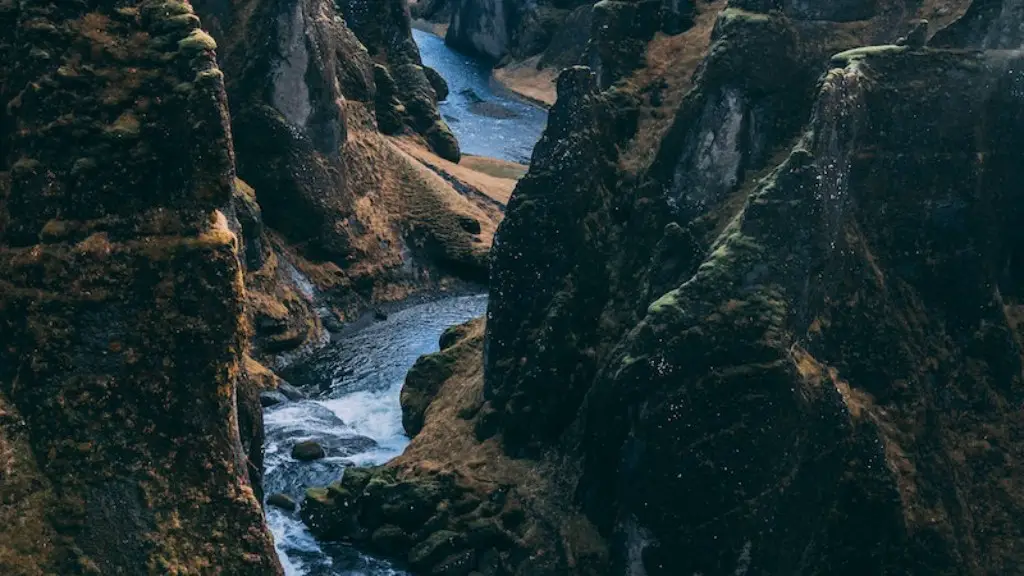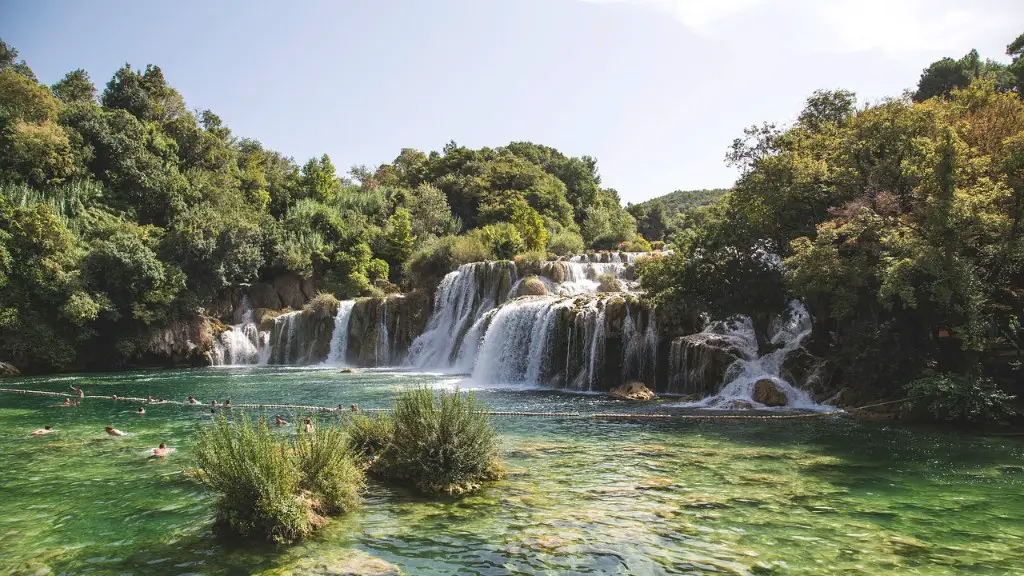The Mississippi River is one of the Earth’s major rivers and is considered by some to be the fourth longest river on the planet. Stretching from its source in the northern Midwest to the Gulf of Mexico, it winds through 10 states, serves over 18 million people, and provides abundant resources. It’s an integral part of America’s history, flora and fauna, and culture, and so it’s worth understanding exactly where it starts.
The source of the Mississippi River is located in Lake Itasca, in north-central Minnesota. The lake itself is a relatively small, yet beautiful, body of water, with its borders surrounded by grasslands and other delicate ecosystems. From northern Minnesota to the Gulf, the Mississippi River travels 2,320 miles. The source and source of the river, though, are located right here in Lake Itasca.
To really depict the beauty of this place, it may help to think of it as an absolute paradise for canoeists and kayakers. With very shallow waters, and surrounded by wilderness, Lake Itasca is one of the most scenic places to paddle. Throughout the landscape, there are beautiful island and rock formations, bluffs running alongside the water, and thick forests that offer the perfect amount of shade during those hot summer days. From Missouri to Louisiana, Lake Itasca is an ideal starting point for a unique outdoor adventure.
Finding the exact source of the river is made easier by a sign posted near the top of the lake. There is also a rock pile in the center, accompanied by a shallow channel that leads out of the lake. Once out of the lake, the Mississippi travels through a series of large rivers and small streams, slowly growing in size and strength.
While the Mississippi is evidence of nature’s power, it also offers something to humans. The vegetation and wildlife along the river support a wide variety of lifestyles. For example, in Minnesota, there are hundreds of species of fish. Some rely on the river for their sustenance, while others like to live in the tributaries and sloughs. In addition, the river provides nourishment for various migrating birds, mammals, and reptiles. It’s also home to many recreational activities, ranging from swimming and fishing, to visiting the national parks, and pristine lakes and resorts.
The Mississippi is a source of adoration and awe, but it’s also a source of concern. Over time, the river has become increasingly polluted, with chemicals and pollutants washing in from the nearby tributaries. Moreover, the river is also vulnerable to natural disasters. During the recent floods in 2017, hundreds of miles of the river were submerged, leading to serious environmental and economic harm.
Despite all these potential dangers, the Mississippi River remains a symbol of strength and resilience. As it travels through 24 select counties, from Lake Itasca to the Gulf of Mexico, it’s an ever-changing force for good. And, for those of us living near the source, that knowledge carries a special place in our hearts.
Environmental Impact
The Mississippi River has served as a major water artery for thousands of years. But as the population around it has grown, so have the sources of pollution. It’s become a major dumping ground full of chemicals, industrial waste, and agricultural runoff. Already, the river’s aquatic life is beginning to suffer the consequences.
In the last few decades, there have been significant efforts to clean up the river’s waters. Some of these have been successful, like natural purification projects, or the installing of aerators near the source. Others, like federally-regulated water quality standards, have been more controversial. Whatever the efforts have been, they have all been made to improve the health of the river.
And, despite decades of trying, the situation is still dire. Studies have shown that much of the fish, mussels, and turtles living in the river contain toxic compounds, the result of decades of runoff. Even now, nearly half of the river’s tributaries are tested unsafe for swimming due to hazardous levels of chemicals, like E.coli.
More needs to be done to preserve this essential resource. It needs to become a priority for both governments and citizens. Otherwise, the river will remain an ecological disaster.
Economic Benefit
Besides offering aesthetic beauty, the Mississippi River provides countless economic benefits. It’s a major source of transportation, allowing goods and services to travel across thousands of miles of waterways. It’s also a primary source of water for agriculture, which serves not only as food, but also as a source of fuel and raw materials.
The river’s banks also offer access to recreational activities, such as fishing, hunting, swimming, and camping. This draws in tourists from all over, boosting local businesses and enriching the economies of nearby rural communities. The river is even a major source of energy, with hydropower turbines tapping into its currents to generate clean, sustainable electric power.
As the region’s major waterway, the Mississippi River carries a tremendous amount of economic value. For every gallon of water that moves through, there’s an impact to the global economy. That’s why, if the river were to become unnavigable, the ramifications could be catastrophic. Fortunately, for now at least, it still serves as a major source of commerce, opportunity, and prosperity.
Infrastructure Challenges
As the Mississippi River continues to grow, so too does the demand for infrastructure. To make sure that it can continue to serve its 18 million human users, governments must invest heavily in its maintenance. Part of this maintenance involves restoring levees and making sure that they are up to date. This means they must replace deteriorated sections, fortify existing ones and add extra protection.
Another part of the infrastructure focus must be on navigation. The Mississippi River is a deep and wide waterway, yet it’s still home to hundreds of sandbars and other landform obstructions. To keep the river flowing and navigable, the US Army Corps of Engineers must regularly dredge and remove these features, improving the river’s usability and safety.
In addition, the US Corps of Engineers must also construct locks and dams, and make sure that the gas and oil pipelines running beneath the waters remain operational. Lastly, the river’s tributaries must also be addressed, making sure that they remain free-flowing and clean, offering the right balance between wildlife and industry.
The Mississippi River carries tremendous potential for growth and development, yet it also carries potential for destruction. That’s why governments need to commit more resources to maintain the river’s infrastructure, making sure that it remains a safe and navigable waterway for centuries to come.
Conservation Efforts
The Mississippi River is a beautiful and precious natural resource that should be preserved and protected for future generations. Conservation efforts are important for this, making sure that any activities near the river do not damage its delicate ecosystems. This includes limiting over-hunting and agricultural runoff, and cracking down on polluters.
Fortunately, preserving the Mississippi is both a local and a federal responsibility. Locally, there are numerous organizations and individuals that are dedicated to preserving the river, outfitting its banks with tree buffers, planting native seeds, and introducing habitat restoration measures. At the national level, federal agencies make sure that any new dams or locks are up to date and efficient.
In addition to these measures, the US Environmental Protection Agency has created several initiatives aimed at protecting the river’s water quality, such as the Clean Water Act. This federal law helps protect rivers from pollution by forcing companies to clean up after themselves and comply with safety standards.
Ultimately, the goal of any conservation effort is to make sure that the Mississippi River remains an iconic symbol of American history, culture, and natural beauty. By investing in its preservation, we can guarantee that its future will remain just as bright as its past.
Educating the Next Generation
The river is an important teaching tool, offering an unforgettable outdoor experience for those who visit its banks. Whether it’s a canoe trip through its winding turns, or a hike through its lush wetlands, there’s something to be discovered and admired.
Education is also getting a boost from the Mississippi River, as many schools are now offering curriculum focused on the river’s ecology and science. By visiting its source in Lake Itasca, students can learn firsthand about its importance and gain a better understanding of what they can do to improve its health in the future.
Encouraging children to interact with the river helps forge a lifetime connection and inspires them to take part in its conservation and preservation. After all, the planet’s future depends on the next generation’s knowledge, and their willingness to get involved.
The Mississippi River serves as the backbone of America, powering not just nearby humans and wildlife, but the entire country. From its starting point in Lake Itasca, it provides countless economic, environmental, and educational benefits, and it deserves our utmost respect. That’s why investing in its future is not only a moral imperative, but a social and environmental obligation too.





